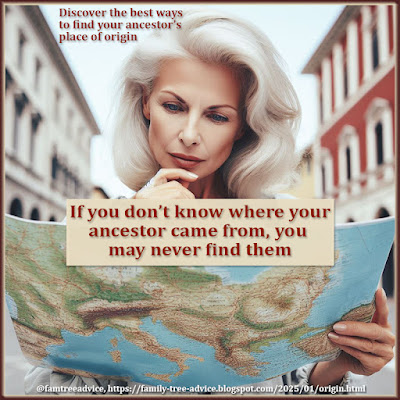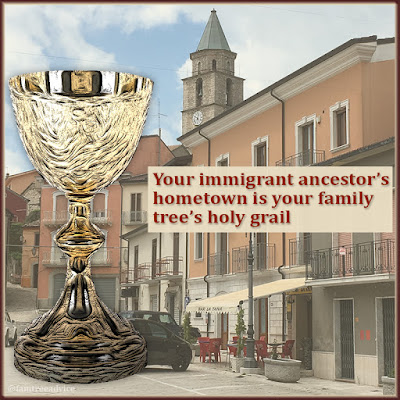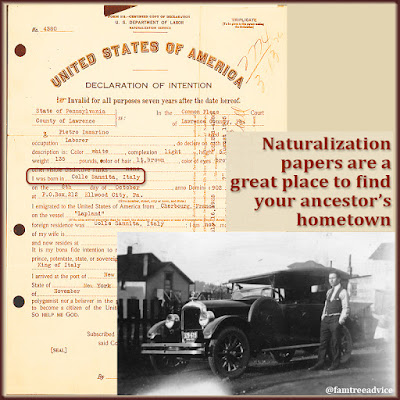If you're over 21, you probably had your last world geography lesson a long time ago. How many details can you remember about countries other your own? For example, I'm from the USA, and I realized I can't name more than half the provinces in neighboring Canada.
There's an easy way to learn about your immigrant ancestors' homeland. Understanding the regions, states, and cities will inform your genealogy research.
How to Use This Free Resource
The FamilySearch Wiki offers a free, easy-to-use guide to the country of your choice. On the Wiki's main page you'll see a map of the world. Start by clicking a continent, then choose a country. I'm going to start with England.
 |
| This free genealogy resource makes those overseas homelands seem closer and more familiar. |
When I click the continent of Europe, I see an alphabetical list of its countries. I'll click England. Then I see an alphabetical list of all the English counties. Since I'm not sure which county I need, I'll click the country name at the top of the list.
Once you choose a country, you'll see a more detailed map. This map divides the country into its sections. These may be counties, provinces, prefectures, states, regions—it depends on the country. Beneath the maps is a list of the sections, each with a link to more detailed information.
There are people in my family tree from Derbyshire, so I'll start there. The detail page tells me there are 132 parishes in the county. I know this family lived in Spondon. In the list of Derbyshire parishes, I'll go to the letter S and click Spondon.
At this town level, you can find links to document collections, maps, and many references. I like the country map showing all the counties. In my family tree, one English group is from Derbyshire, and another is from Lancashire. Seeing this map, I learn that Derbyshire borders Lancashire. That's quite a coincidence.
When I click the continent of Asia and the country of Japan, I see a list of the 47 prefectures within the eight regions. My husband's ancestors came from Hiroshima, and I see that's in the Chūgoku region. (I didn't know that off the top of my head.) The Japan section of the Wiki doesn't have much detail. But it does have a link to a very detailed Wikipedia page. There I found that Hiroshima is on the island of Honshu, which is where you'll find Mount Fuji.
I have cousins whose Italian ancestors emigrated to Brazil. (See "How to Make the Most of an Intriguing Genealogy Lead".) I'm not at all familiar with the geography of that country. I'll click the South America continent and the country of Brazil on the FamilySearch Wiki. First I see a map breaking down the five regions and 27 states. Did you know Brazil has 27 states? I didn't.
Many of these cousins went to Itapira in São Paulo, but I don't have a feel for where that is on a map. On the FamilySearch Wiki page for Brazil, I'll click the São Paulo state. First I see that the state borders the Atlantic Ocean, and it's pretty far south in the country. When my cousins arrived, the city of São Paulo was a convenient location, populous and not too far from the shore.
The state has tons of municipalities. I'll click the only one I can tie to these cousins: Itapira. This page links to document collections that can be very useful to my research.
It should be fun to look at a more familiar location, like the place where I grew up. (See also "Discover Your Ancestral Hometown's History".) I'll click the North America continent, the United States, New York, and Rockland County. Here I find a list of populated places. It's divided into towns, villages, hamlets, census-designated places, and one ghost town!
They created the ghost town in 1928 by submerging a settlement of 30 houses to create a lake I visited as a kid. I never heard about this before!
The place I lived for most of my school years (age 5–19) is a "census-designated place" that covers only 2.2 square miles. But my old house sits in a village that didn't exist until four years after my family moved away. The information about the village led me to a collection of historical photos that blew my mind.
When I was in school, I used to ride my bike to a beautiful street nearby called Wesley Chapel Road. I brought a camera along and photographed some of my favorite old houses. The village's website features one of those farm houses in a photo. The house dates back to 1896. There's also a 1904 photo of a little house my family passed all the time. It shows a big family standing by the picket fence.
I learned they named one of the main streets nearest my old house, Forshay Road, after W. Spencer Forshay. He established a cigar manufacturing shop there in 1851. I never thought about the area being that old. I can relate to the photo of a snow-covered street near the school where I attended 1st and 2nd grade. It seemed to snow all winter long when I was a kid.
If I can find fun new facts about the place where I grew up, imagine what you can find about the places your ancestors lived.
Whichever country you choose to explore, be sure to look at the right column on the map page. This can contain:
- beginning research tips
- types of records kept
- historical and cultural background
- local research resources, and more.
Where does your genealogy research tell you to explore first?


















